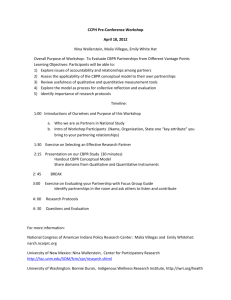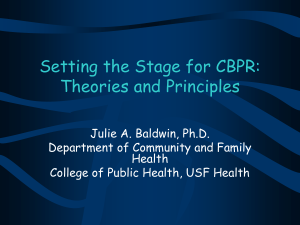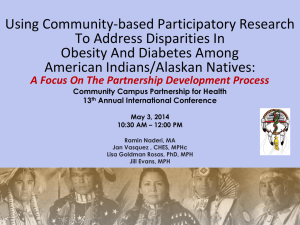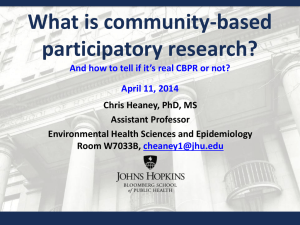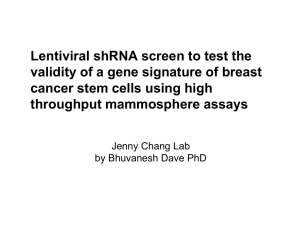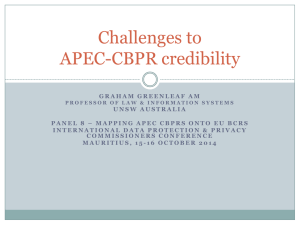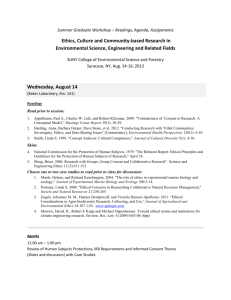Module_3_Report--Albert_Chi
advertisement
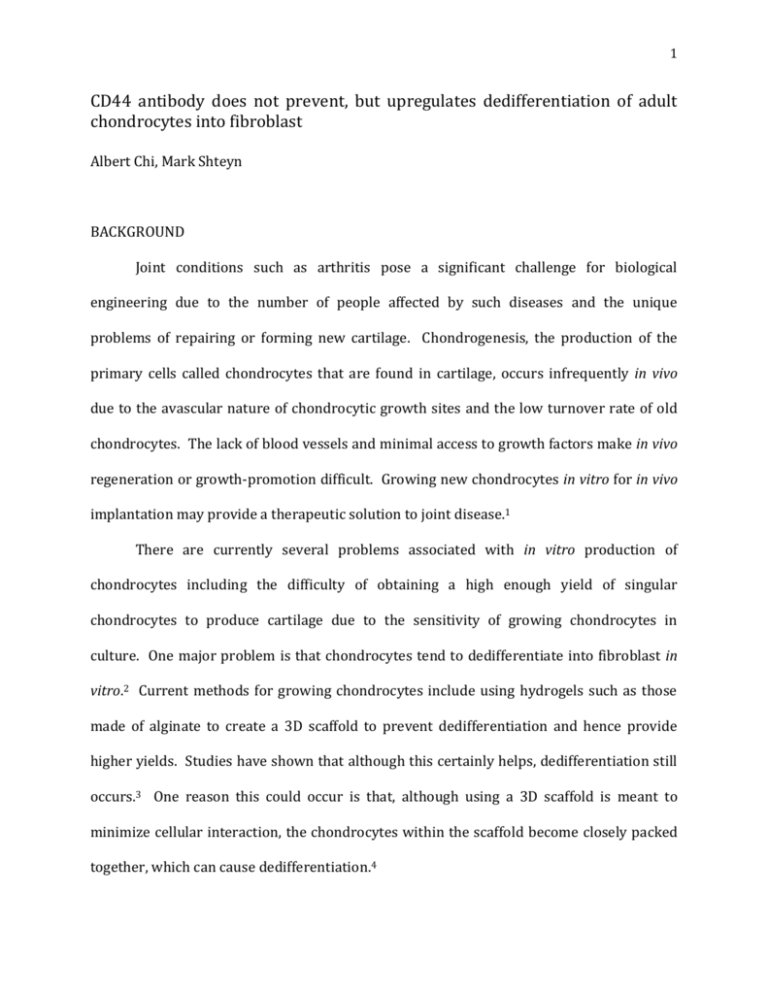
1 CD44 antibody does not prevent, but upregulates dedifferentiation of adult chondrocytes into fibroblast Albert Chi, Mark Shteyn BACKGROUND Joint conditions such as arthritis pose a significant challenge for biological engineering due to the number of people affected by such diseases and the unique problems of repairing or forming new cartilage. Chondrogenesis, the production of the primary cells called chondrocytes that are found in cartilage, occurs infrequently in vivo due to the avascular nature of chondrocytic growth sites and the low turnover rate of old chondrocytes. The lack of blood vessels and minimal access to growth factors make in vivo regeneration or growth-promotion difficult. Growing new chondrocytes in vitro for in vivo implantation may provide a therapeutic solution to joint disease.1 There are currently several problems associated with in vitro production of chondrocytes including the difficulty of obtaining a high enough yield of singular chondrocytes to produce cartilage due to the sensitivity of growing chondrocytes in culture. One major problem is that chondrocytes tend to dedifferentiate into fibroblast in vitro.2 Current methods for growing chondrocytes include using hydrogels such as those made of alginate to create a 3D scaffold to prevent dedifferentiation and hence provide higher yields. Studies have shown that although this certainly helps, dedifferentiation still occurs.3 One reason this could occur is that, although using a 3D scaffold is meant to minimize cellular interaction, the chondrocytes within the scaffold become closely packed together, which can cause dedifferentiation.4 2 One way to prevent dedifferentiation is by adding proteins or other biochemical factors.5 CD44 is a cell-surface protein that is involved with cell-cell interaction and adhesion and has been implicated in the dedifferentiation/redifferentiation pathway of chondrocytes into fibroblast.6-7 In the dedifferentiated state, CD44 levels have been shown to be elevated, whereas in the chondrocytic state, a decrease in CD44 concentration occurs. Recently, CD44 antibody has also been shown to affect differentiation during chondrogenesis from mesenchymal stem cells.8 Stem cells, however, are difficult to maintain and produce lower yields than adult chondrocytes. We therefore investigated the addition of CD44 antibody to adult chondrocytes grown in a 3D scaffold to see if this method of direct CD44 inhibition will produce better yield during in vitro chondrogenesis. DESIGN We used a 1% alginate gel formed in beads and grown in standard medium. We added bovine CD44 antibody at least twice a week for 2 weeks. Cell viability assay was done using the LIVE/DEAD test kit. RT-PCR was performed before transcript analysis on a 1.2% agarose gel, checking for type 1 collagen and type 2 collagen in a sample containing CD44 against a control without CD44. We analyzed cell viability and gel data using the image program ImageJ. ELISA protein assay was performed to check for CN1 and CN2 relative to CD44. RESULTS Cell Viability 3 (B) (A) (C) 1 2 3 4 5 Avg Area XStart YStart 22.015 1968 481 17.541 1626 534 92.512 2075 810 21.986 741 1144 116.347 1379 1537 54.0802 Figure 1 – Cell viability assay. Cell growth was not affected by the addition of CD44. Cells were stained with STYO10 (green) and ethidium homodimer-2 (red) using the LIVE/DEAD kit and inspected under a fluorescence microscope. (A) An unfiltered photo of cells excited for green fluorescence. (B) Image of viable cell outlines as analyzed by ImageJ with an adjustment for contrast and threshold to decrease noise. (C) Table of cells detected and their areas. Cell growth was decreased by the addition of CD44 antibody, although the bead itself was particularly delicate and brittle to pipetting. Cells were assayed with LIVE/DEAD test kit, analyzed through a fluorescence microscope at FITC excitation for lives cells and EthD-1 excitation for dead cells (Figure 1a). Images from microscopy were analyzed through ImageJ to give us cell counts and cell sizes (Figure 1b, c). RT-PCR and Gel Electrophoresis Ratios CN1/GAPDH CN2/GAPDH CD44 Control 2.435897 1.99322 0.660108 0.855944 Figure 2 – Transcript assay. RNA RT-PCR fragments were run through gel electrophoresis in a 1.2% agarose gel at 125V for 45 minutes and analyzed with ImageJ. Samples run are CNI control, CNI+CD44, CNII control, and CNII+CD44 (labeled above). ImageJ analysis showed that whereas the CN1/GAPDH ratio for CD44 was heightened versus control, CN2/GAPDH was decreased. Transcript assay showed that dedifferentiation occurred even with the addition of CD44 antibody, in fact increasing the rate of fibroblast formation relative to control. GAPDH was our control signal (Figure 2, image). Comparing Collagen 1 4 (CN1)/GAPDH ratios and Collagen 2 (CN2)/GAPDH ratios between samples with CD44anbtibody added and controls showed that CD44 antibody increased type 1 collagen expression (fibroblast) and decreased type 2 collagen expression (chondrocytes) (Figure 2, table). ELISA Protein Assay ELISA assay showed that CN1 was thoroughly expressed, whereas CN2 measurements were insignificant (yielding negative values) (Figure 3). The control concentration gradient data was regressed linearly to calculate the concentrations of CN1 and CN2. CN1 concentration was Protein Concentration vs. Absorbance 350 Collagen I Standards Collagen II Standards Collagen I Experimental Collagen I Control Collagen II Experimental Collagen II Control Linear (Collagen I Standards) Linear (Collagen II Standards) Protein Concentration (ng/mL) 300 250 200 150 100 50 0 0 -50 0.1 0.2 0.3 Absorbance 0.4 0.5 0.6 y = 717.03x + 4.9289 R² = 0.9995 y = 541.76x - 10.14 R² = 0.9399 Figure 3 – ELISA results. ELISA ran at 26.4˚C to detect type 1 and type 2 collagen absorbance in samples containing CD44 and compared to a standard gradient curve (the line of best fit and its equation is shown). Through this analysis we were able to see that CN1 was more highly expressed in samples containing CD44 whereas both CD44+ and CD44- results showed a lack of significant results for CN2 concentration. 5 much higher in samples with CD44 added than control with a difference of 177.4 ng/mL, from 40.5 ng/mL in CD44- control to 224.0 ng/mL in CD44+ (about a five-fold increase). DISCUSSION/FUTURE WORK CD44 antibody is ineffective in decreasing the rate of chondrocyte dedifferentiation into fibroblast, in fact seemingly increasing the rate of dedifferentiation. The gel analysis from RT-PCR shows that CN1 was more highly expressed while CN2 was downregulated relative to control. The increased concentration of CN1 in samples with CD44 antibody also indicates that dedifferentiation was promoted, rather than inhibited by the addition. The low detection of CN2 concentration in our samples shows that there was much more fibroblast than chondrocytes. The cell viability tests show that CD44 antibody addition did not affect cellular growth, but did affect cell differentiation as very few cells were observed. One possible explanation for the lack of regulation of dedifferentiation by the addition of CD44 antibody is that the CD44 antibody did not affect CD44 functionality. CD44 is a receptor that is perhaps better inhibited by the use of a ligand inhibitor. The attachment of antibody to the receptor could block the active sites, but it could also not. CD44 antibody could have also increased the concentration of CD44 in the culture by exposing it more, which would increase dedifferentiation. To measure this effect, we could have used the CD44 antibody to run a direct ELISA to detect CD44 concentrations. We should have also tested for CD44 antibody concentrations to be able to make relations between CD44 antibody concentrations to CD44 concentrations and finally to CN1 and CN2 concentrations. Further experimentation on the possible regulation of dedifferentiation via CD44 could be done by the trial of certain inhibitors, rather than antibodies, which would 6 better permeate through the alginate scaffold by nature of their smaller size. Another interesting experiment could be to silence CD44 expression using siRNA instead of a chemical substrate. REFERENCES 1. Gomez-Camarillo MA, Almonte-Becerril M, Vasquez Tort M, Tapia-Ramirez J, Kouri Flores JB. Chondorcyte proliferation in a new culture system. Cell Prolif. Apr 2009; 42(2):207-18. 2. Gomez-Camarillo MA, Almonte-Becerril M, Vasquez Tort M, Tapia-Ramirez J, Kouri Flores JB. Chondorcyte proliferation in a new culture system. Cell Prolif. Apr 2009; 42(2):207-18. 3. Lee CSD, Gleghorn JP, Choi NW, Cabodi M, Stroock AD, Bonassar LJ. Integration of layered chondrocyte-seeded alginate hydrogel scaffolds. Biomaterials 2007; 28:2987-2993. 4. Genes NG, Rowley JA, Mooney DJ, Bonassar LJ. Effect of substrate mechanics on chondrocyte adhesion to modified alginate surfaces. Biochemistry and Biophysics 2004; 422:161-167. 5. Hoben GM, Willard VP, Athanasiou KA. Fibrochondrogenesis of hESCs: growth factor combinations and cocultures. Stem Cells Dev Mar 2009; 18(2):283-92. 6. Yoshida M, Yasuda T, Hiramitu T, Ito H, Nakamura T. Induction of apoptosis by anti-CD44 antibody in human chondrosarcoma cell line SW1353. Biomed Res. Feb 2008; 29(1):47-52. 7. Yanada S, Ochi M, Adachi N, Nobuto H, Agung M, Kawamata S. Effects of CD44 antibody – or RGDS peptide – immobilized magnetic beads on cell proliferation and chondrogenesis of mesenchymal stem cells. J Biomed Mater Res A 2006 Jun 15; 77(4):773-84. 8. Albrecht C, Schlegel W, Eckl P, Jagersberger T, Sadeghi K, Berger A, Vécsei V, Marlovits S. Alterations in CD44 isoforms and HAS expression in human articular chondrocytes during the de- and re-differentiation processes. Intnat’l Journal of Mol Med Feb 2009; 23(2):253259.
